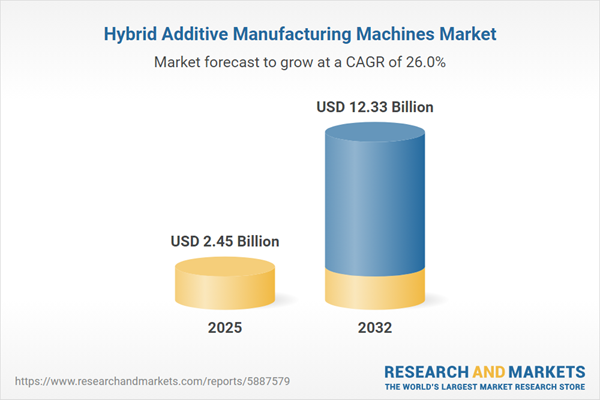Speak directly to the analyst to clarify any post sales queries you may have.
Hybrid additive manufacturing machines are transforming industrial manufacturing, offering senior decision-makers advanced tools for responding to market changes and aligning operational capacities with evolving business objectives. By combining additive and subtractive processes, these systems support dynamic, flexible production models critical for today’s competitive landscape.
Market Snapshot: Hybrid Additive Manufacturing Machines Market
The hybrid additive manufacturing machines market is expected to reach USD 1.94 billion in 2024, with projections indicating growth to USD 2.45 billion by 2025 and a notable CAGR of 25.99%. Growth is being driven by robust adoption across aerospace, energy, automotive, and medical sectors, where expedited product development and improved regulatory response are vital. Organizations leveraging these systems can respond to increasing demands for custom solutions and accelerate delivery schedules, while the integration of additive and traditional capabilities streamlines supply chain operations and ensures customer specifications are met.
Scope & Segmentation
- Technology Types: Directed energy deposition, laser metal deposition, wire arc additive manufacturing, material extrusion, powder bed fusion, and sheet lamination each serve unique production roles in integrated hybrid systems.
- Material Types: Industrial metals including aluminum, titanium, stainless steel, and advanced polymers deliver high performance across challenging industrial sectors.
- End User Industries: Aerospace, energy, automotive, and medical manufacturing integrate hybrid machines for new component fabrication as well as ongoing maintenance, ensuring high levels of innovation and quality assurance.
- Applications: Organizations use hybrid systems for mass production, rapid prototyping, component repair, legacy part remanufacturing, and managing full product lifecycles through integrated workflows.
- Feedstock Types: Both powder and wire feedstocks support adaptable production ranges, from specialized small batches to high-volume manufacturing.
- Power Sources: Electron beam, laser, and plasma-based systems extend compatibility across materials, letting organizations choose power options best matching operational requirements.
- Build Volume Ranges: Machine platforms range from compact designs for limited spaces to large systems tailored to extensive industrial deployments.
- Regional Coverage: The Americas, Europe, Middle East, Africa, and Asia-Pacific each exhibit distinct technology investment practices, research activity, and sector priorities influencing adoption rates.
- Leading Companies: Providers like DMG Mori, Yamazaki Mazak, Matsuura Machinery, TRUMPF, Okuma, Sodick, JTEKT, Hurco, AddUp, and GROB-WERKE deliver specialized equipment and integrated services to meet specific operational demands.
Key Takeaways for Senior Decision-Makers
- Hybrid additive manufacturing facilitates precision engineering at every step of the product lifecycle, enabling organizations to address complex and shifting customer or market needs efficiently.
- Digital controls with real-time analytics provide operational transparency, improving scheduling and reducing unforeseen downtime across manufacturing environments.
- Integration with automated systems and digital twins enables unified workflows, delivering insights that optimize performance and teamwork.
- Adaptation of hybrid manufacturing is best managed by aligning investments to industry-specific demands and varying regional regulations, optimizing both compliance and ROI.
- Diverse machine configurations and feedstock formats increase supply chain agility, supporting organizations as they react to evolving demand signals or compliance mandates.
Impact of Tariff Policy on Hybrid Additive Manufacturing
Recent changes in U.S. tariff policies on imported metal powders and equipment are influencing procurement strategies in the hybrid additive manufacturing sector. Companies are prioritizing local powder production, establishing varied supplier networks, and evaluating nearshore manufacturing solutions. These steps are improving risk management, reducing sensitivity to volatile global prices, and supporting stronger alignment with shifting trade conditions.
Methodology & Data Sources
This report gathers insights from interviews with equipment manufacturers, material experts, systems integrators, and end users. Findings are validated through in-depth reviews of technical literature, patent analysis, and regulatory assessment to ensure outcomes are reliable and actionable for industry stakeholders.
Why This Report Matters
- Delivers analytical insights enabling senior management to prioritize hybrid additive manufacturing investments aligned with operational agility and resilience.
- Provides strategies supporting resource allocation and supply chain enhancements amid continuously evolving manufacturing standards and compliance frameworks.
- Equips organizations with intelligence for informed planning, helping them navigate new technology trends and respond confidently to shifts in regional market environments.
Conclusion
Implementing hybrid additive manufacturing allows organizations to boost flexibility, strengthen control of processes, and enhance reliability across operations. Targeted system integration positions companies for resilient, adaptable, and efficient industrial performance.
Additional Product Information:
- Purchase of this report includes 1 year online access with quarterly updates.
- This report can be updated on request. Please contact our Customer Experience team using the Ask a Question widget on our website.
Table of Contents
3. Executive Summary
4. Market Overview
7. Cumulative Impact of Artificial Intelligence 2025
Companies Mentioned
The companies profiled in this Hybrid Additive Manufacturing Machines market report include:- DMG Mori Co., Ltd.
- Yamazaki Mazak Corporation
- Matsuura Machinery Corporation
- TRUMPF GmbH + Co. KG
- Okuma Corporation
- Sodick Co., Ltd.
- JTEKT Corporation
- Hurco Companies, Inc.
- AddUp SAS
- GROB-WERKE GmbH & Co. KG
Table Information
| Report Attribute | Details |
|---|---|
| No. of Pages | 185 |
| Published | November 2025 |
| Forecast Period | 2025 - 2032 |
| Estimated Market Value ( USD | $ 2.45 Billion |
| Forecasted Market Value ( USD | $ 12.33 Billion |
| Compound Annual Growth Rate | 25.9% |
| Regions Covered | Global |
| No. of Companies Mentioned | 11 |









